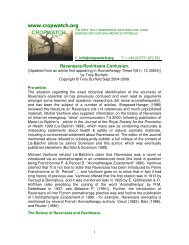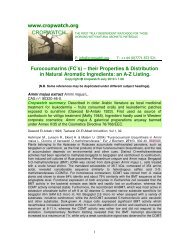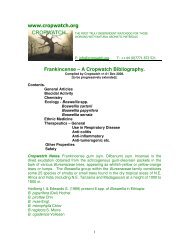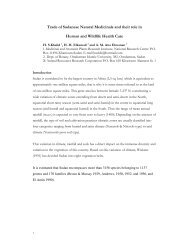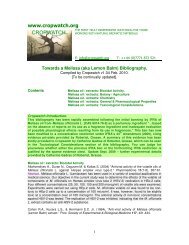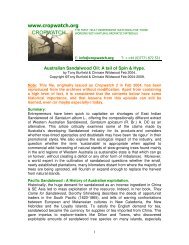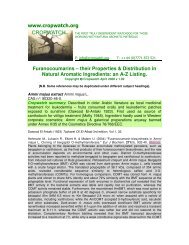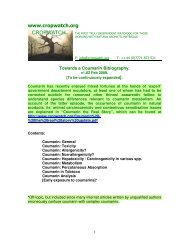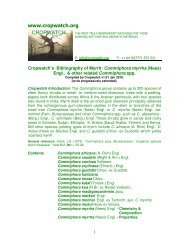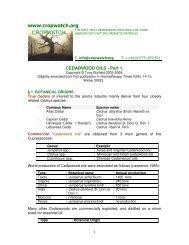Sandalwood Biblio - Cropwatch
Sandalwood Biblio - Cropwatch
Sandalwood Biblio - Cropwatch
You also want an ePaper? Increase the reach of your titles
YUMPU automatically turns print PDFs into web optimized ePapers that Google loves.
Jirovetz L. et al. (1988). “Differentiation of double bond isomers of sesquiterpene alcohols in East<br />
Indian sandalwood oil by means of GC-MS and GC-FTIR: Dihydrosantalols.” Spectroscopy 6(5-<br />
6), 283-294.<br />
John M.D., Paul T.M. & Jaiswal P.K. (1991) “Detection of adulteration of polyethylene glycol in oil<br />
of sandalwood” Indian Perfumer 35(4), 186-187..<br />
Kim T.H., Ito H., Hayashi K., Hasegawa T., Machguchi T., & Yoshida T. (2005) "Aromatic<br />
constituents from the heartwood of Santalum album." Chem Bull Pharm (Tokyo) 53(6), 641-646.<br />
Abstract: A phytochemical investigation of the polar constituents in the heartwood of Indian<br />
Santalum album L. resulted in the isolation of three new neolignans (1-3) and a new aromatic<br />
ester (4), along with 14 known components. The structures of the new compounds (1-4) were<br />
established using spectroscopic methods.<br />
Kim T.H., Ito H., Hatano T., Haswegawa T., Akiba A., Machiguchi T., Yoshida T. (2005)<br />
"Bisabolane & santalane-type sequiterpemoids from Santalum album of East Indian origin" J. Nat<br />
Products 68(12), 1805-1808. Abstract: Six new bisabolane-type (1-3) and santalane-type (4-6)<br />
sesquiterpenoids, together with (+)-alpha-nuciferol, (+)-citronellol, and geraniol, were isolated<br />
from the heartwood of Santalum album of Indian origin. Their structures, including two bisabolol<br />
diastereomers (1, 2), were established on the basis of spectroscopic data interpretation.<br />
Kovatcheva A., Buchbauer G., Golbraikh A. & Wolschann P. (2003) “QSAR modeling of alphacampholenic<br />
derivatives with sandalwood odor.” J Chem Inf Comput Sci. 43(1), 259-66. Abstract.<br />
Three-dimensional quantitative structure-activity relationship (3D-QSAR) models were developed<br />
for a series of 44 synthetic alpha-campholenic derivatives with sandalwood odor. These<br />
compounds have complex stereochemistry as they contain up to five chiral atoms. To address<br />
stereospecificity of odor intensity, a 3D-QSAR method was developed, which does not require<br />
spatial alignment of molecules. In this method, compounds are represented as derivatives of<br />
several common structural templates with several substituents, which are numbered according to<br />
their relative spatial positions in the molecule. Both wholistic and substituent descriptors<br />
calculated with the TSAR software were used as independent variables. Based on published<br />
experimental data of sandalwood odor intensities, two discrete scales of the odor intensity with<br />
equal or unequal intervals between the threshold values were developed. The data set was<br />
divided into a training set of 38 compounds and a test set of six compounds. To build QSAR<br />
models, a stepwise multiple linear regression method was used. The best model was obtained<br />
using the unequal scale of odor intensity: for the training set, the leave one out cross-validated<br />
R(2) (q(2)) was 0.80, the correlation coefficient R between actual and predicted odor intensities<br />
was 0.93, and the correlation coefficient for the test set was 0.95. The QSAR models developed<br />
in this study contribute to the better understanding of structural, electronic, and lipophilic<br />
properties responsible for sandalwood odor. Furthermore, the QSAR approach reported herein<br />
can be applied to other data sets that include compounds with complex stereochemistry.<br />
Kretschmar H.C., Barneis Z.J. & Erman W.F. (1970) “The isolation & synthesis of a novel<br />
tetracyclic ether from East Indian sandalwood oil. A facile intramolecular Prins reaction.”<br />
Tetrahedron Letters 11(1), 37-40.<br />
Kuttan R. & Radhakrishnan A.N. (1972) "Studies on the biosynthesis of sym-homospermidine in<br />
sandal (Santalum album L.)." Biochem J. 127(1), 61-67. Abstract. The biosynthesis of the newly<br />
isolated polyamine, sym-homospermidine (NH2–[CH2]4–NH–[CH2]4 –NH2), was studied by<br />
using radioactive amino acids. Arginine was the most effective precursor, being about 10 times as<br />
active as ornithine. Unlabelled agmatine and putrescine markedly inhibited the incorporation of<br />
[14C]arginine into homospermidine. Similarly the incorporation of ornithine was inhibited by<br />
unlabelled arginine and putrescine. γ-Aminobutyraldehyde, the oxidation product of putrescine,<br />
was considered to be one of the intermediates in the biosynthesis of homospermidine. The<br />
biosynthesis may involve a Schiff-base formation of putrescine with γ-aminobutyraldehyde and<br />
subsequent reduction. A limited synthesis of spermidine also takes place under these conditions.<br />
36





